|
"Pilots talk", read more here...
New page for comments, send me an mail: 
2004:
A tragic day for 26 sqn read more...
And see if you can help us
As you se I 'am in the process of gathering information for this page and don't hesitate to contact me if you have some new information.
News from Norway aug 2000: If you visit the new Airplane Collection at Gardermoen Airport, you will find a showcase dedicated
to Agnes and Dougal Murray.

Can anyone give me the history of this pic? Dougal Murray 3 row 8 from left.
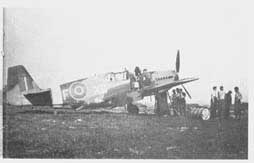 |
In January, 1943, F/O. Murray penetrated deep into Northern France, and despite intense fire from the defenses, inflicted much damage on enemy transport and caused casualties to German infantry. He has also secured some excellent photographs taken at low level in the face of enemy fire." At the time No. 26 Squadron was flying Mustang aircraft on tactical reconnaissance and day intruder missions. No. 26 Sq. used the north American Mustang I for most of its offensive sorties in WW II.  |
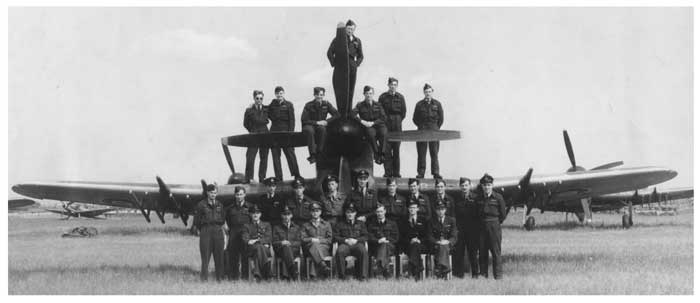
Can anyone give me the history of this pic? Dougal Murray 1 row 4 from left.
I think this is in Sqn 137
RAF Squadron no. 26
Badge: A springbok's head coped. Motto: " 'N Wagter in die Lug" ("The Watcher in the Sky").
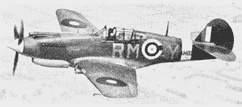 Tomahawk HA (AH 898) of No. 26 Squadron. (Imp. War Museum Photo) Tomahawk HA (AH 898) of No. 26 Squadron. (Imp. War Museum Photo)
The springbok, emblem of South Africa, commemorates the squadron's service with Gen. Smuts' forces in German East Africa and the fact that it originally comprised South African aircrew. The squadron was formed at Netheravon on 8th October, 1915, out of a nucleus of South African flyers who had already served in the campaign in German South-West Africa. It sailed for Mombasa in December and in 1916 was split into several detached flights for the East African campaign in which it served as a reconnaissance squadron. This lasted for two years after which it made a slow return to England via Egypt arriving in July, 1918, and disbanding at Blandford that month.
It re-formed at Catterick on 11th October, 1937, as an Army- Cooperation squadron and served in this role until the end of the Second World War, being involved in the French campaign of 1940 with Lysanders and then working up in this country for the Second Front. In this it flew Spitfires and then Mustangs on fighter-reconnaissance duties.
At the end of the war it was disbanded but re-formed on 1st April, 1946, from No 41 Squadron at first with Spitfire FR14's and PR11's and then, from January, 1947, with Tempest F2's in the fighter role. It was part of the BAFO. and its successor, 2nd TAF. With the Tempests it worked up in the rocket role for ground attack operations in addition to the interceptor role.
Two years later the squadron received jet re-equipment in the form of Vampire FB5's which were also rocket-equipped. In 1953, with the expansion of British Forces in Germany, No 26 converted to Sabre Fl's to concentrate on day interceptor duties. As such it was involved in scrambles to contact any unidentified aircraft appearing over British Zone airspace. The Sabre being an interim aircraft it gave way nineteen months later to the Hunter F4.
In 1957 it was disbanded but again reformed with Hunters in Germany. It was again disbanded in 1961 and reformed as a helicopter squadron in Aden equipped with Belvedere HC1's. In February, 1969 it became a communications squadron with Bassets, Devons and Pembrokes.

The photo of B Flight was taken in August 1943 at Ballyhalbert in Northern Ireland, when the flight was detached from the rest of the Squadron based at Church Fenton. I can identify most of the pilots in the front row: 1,2,3 Flying Officers Hughes, McKinnon and Stooks 4 ground-crew Flight Sergeant 5 Flg Off Doug Murray 6 Flt Lt Kit North-Lewis � (the flight commander) 7 forgotten! 8 ground-crew Sergeant 9 Army Liaison Officer 10 Flt Lt Pope 11 Flg Off Griffiths (Me!) The aircraft is a Mustang Mk1 � the early version with the Allison engine.
Regards Arthur Griffiths
Thank you to Arthur Griffiths that did send this info dec 2000.
Des 2003 sad news:
I have just received news via a friend, from Mrs Nancy Griffiths who told that Air Vice Marshall Arthur Griffiths died earlier this year.
From: "Fighter Squadrons of the RAF" by J Rawlings
In 1939 Squadron 26 was based at Catterick (North Yorkshire) and was equipped with Lysanders (replacing the older Hawker Hectors). During the period 8 June - 3 September 1940 the squadron was based at West Malling (North Kent) and was still equipped with Lysander (by now Lysander IIIs). The Lysander was a single engine 2 seater high winged aircraft used for army co-operation (spotting, reconnaissance, ground attack etc) - unlike other armies the RAF controlled all British military aircraft at the time.
The Lysander was in use up until 1942 when the last of them were replaced by Hurricanes - another British aircraft (this was with 28 squadron).
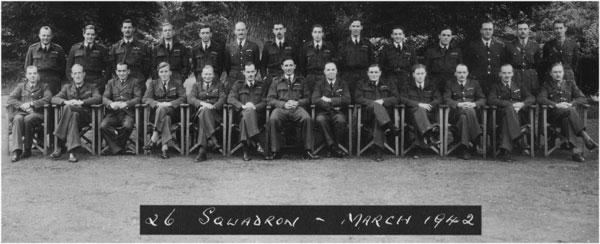
In the book Royal Air Force 1939-45, vol. I By Denis Richards. Page 406 Appendix III.
Royal Air Force Command Organization, September 1939. Air Ministry | Home Commands | Air Component B.E.F and No. 22 Army Co-operation Group | 13 Squadrons Nos. 1,2,4,13,16,26,53,59(4),73,85,87(4),613,614.
In the book Royal Air Force 1939-45, vol. III By Hilary St. George Saundes. Page 412-13 Appendix XI.
Order of Battle, Allied Expeditionary Air Force 6th June 1944. In Second Tactical Air force, Squadron 26 and 63 flying Spitfire.
The Squadrons of the RAF, by James Halley. 2
6 Sqn RAF operated the following American aircraft during WW II. Tomahawk II from Feb 1941 to Mar 1942 Mustang I from Jan 1942 to Mar 1944 Mustang I from Nov 1944 to Jun 1945
From "Squadron Histories, RFC, RNAS and RAF since 1912" by Peter Lewis, published by Putnam & Co London, 1968
No. 26 'South African' Squadron Formed Nov 1914, at Netheravon from unit of the South African Aviation Corps.
In Oct 1915, became No 26 'South African' Squadron of the RFC. 1915, BE2c, H Farman F20 (steel version).
To Mombasa 31 Jan 1916. From Aug 1917, used BE2c and BE2e only in East Africa.
Returned to England in July, 1918, and disbanded at Blandford.
Reformed 11 Oct 1927, at Catterick with Atlas first Sqn. 1933, Audax. CO S/L C H Stillwell. 1938, Hector (HL-). 1940, in France with Air Component, BEF, using Lysander 1, 2, 3 (RM-), Battle I (RM-). 1941, Tomahawk F1, F2a (RM-). Feb 1942, Mustang F1, FB4 (RM-, XC-), Spitfire F5, Spitfire PRII, FR14e (XC-).
1 April, 1946, renumbered from No 41 Squadron with Tempest F2, F5 (XC-). 1953, in 2nd TAF at Oldenburg, Germany, with Vampire FBs (XC-).
1954, Sabre F4. CO S/L K Smith. 1955, Hunter F4. CO S/L J A G Jackson. Hunter F6. 1959, at Gutersloh. 1960, CO S/L D L Edmonds. Disbanded 1961. Reformed 1961 with Belvedere HC1. At Khormaksar, Aden. Bases, etc.
Reformed in 1st Apr 1946 by re-numbering No 41 Sqn. at Wunstorf. Wunstorf Apr 1946 Apr 1946 Fassberg Apr 1946 Sep 1946 Chivenor Sep 1946 Nov 1946 Fassberg Nov 1946 Nov 1947 Gutersloh Nov 1947-Jan 1950 Wunstorf Jan 1950-Aug 1953 Oldenburg Aug 1953 Sep 1957
Disbanded at Oldenburg on 15th Sep 1957. Re-formed at Gutersloh Gutersloh -1961 Disbanded at Gutersloh 1961.
Re-forrned as a helicopter Sqn. Main Equipment (in the fighter role) Hawker Tempest F2 (Jan 1947-Apr 1949) eg MW416 XC D MW423 XC J PR685 XC U PR782 XC Q PR853 XC F DH Vampire FB5 (Apr 1949-Jun 1952) eg VV486 XC C VV531 XC N VV664 XC E VX462 XC Z WA395 XC J DH Vampire FB9 (Jun 1952-Nov 1953) eg WL582 WR143 WR149 T WR157 WR177 WR184 WR231 NA Sabre Fl (Nov 1953-Jun 1955) eg XB577 V XB613 C XB700 B XB767 Y XB818 M XB883 A Hawker Hunter F4 (Jun 1955-Sep 1957) eg WT722 S WT769 B WV257 E WW664 C XE668 G Hawker Hunter F6 (-1961) eg XE530 A XE535 F XG292 B XJ636 E
Commanding Officers S/Ldr J F Roberts, DFC Apr 1946-Jan 1947
S/Ldr H Ambrose, DFC Jan 1947-May 1947
S/Ldr J Brandt, DFC May 1947-Dec 1947
S/Ldr A D Mitchell, DFC, AFC Dec 1947-Jun 1948
S/Ldr J W Frost, DFC Jun 1948-Sep 1948
S/Ldr J F McPhie Sep 1948-May 1951
S/Ldr T James May 1951-Mar 1952
S/Ldr K Smith, DFC Mar 1952-Sep 1954
S/Ldr J A G Jackson, DFC, AFC Sep 1954-Oct 1955
S/Ldr J B Jay Oct 1955-Jan 1956
S/Ldr J de M Severne, AFC Jan 1956-Sep 1957
Aircraft Insignia When re-equipping with Tempests the squadron continued to use the code letters "XC" which had been in use with No 26 Squadron since 1943. They were also used on the Vampires until 1951 after which the only squadron identity markings were the carrying of the squadron crest until re-equipment with Hunter F4's when a new official marking was carried; a black rectangle each side of the crest on the nose with a green lightning flash in each segment, the whole surrounded by thin yellow edg�ng. This was retained on the Hunter F6's and has been perpetuated on the fins of the squadron's Belvedere helicopters.
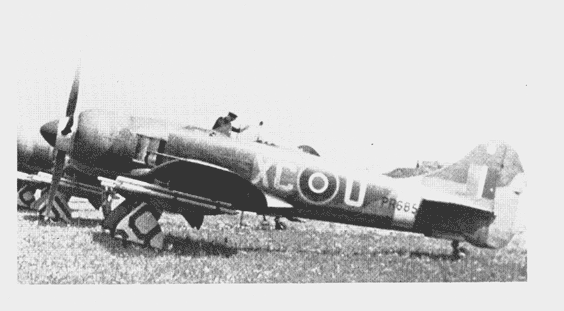 |
Photograph: In January, 1947, No 26 Squaddron was equipped with Tempest F2's; PR685 is seen here, on a visit to Schwechat, with rocket rails under the wings. Apart from the "XC" code letters, the squadron crest is on the.lin and the spinner is tipped blue for "B" Flight. |
"Coastal, Support and Special Squadrons of the RAF and their Aircraft" by John D R Rawlings, 1982, published by Jane's.
The origins of No. 26 Squadron are found in a group of South African officers who learned to fly before World War I and, in November, 1914, comprised a flying unit, set up at Farnborough, to serve in the German South-West African campaign. When this was concluded in July, 1915 this unit returned to the UK and was included in No. 26 (South African) Squadron which formed at Farnborough on 7 October, 1915. Its stay in UK was short, embarking for East African service on 23 December and arriving there in February, 1916. It went into action almost as soon as its aircraft were assembled, flying recess around Sarengeti and dropping bombs on Taveta.
In a campaign of this type the Squadron was closely identified with the army units (of 2nd Division) it was supporting and in the course of the year had many detachments along-side them. The Squadron also co- operated closely with a RNAS detachment of Sqaudrons in the area. Most of the task was reconnaissance but during the rainy season operations ceased and all efforts were made to preserve the aircraft. The offensive was taken up again in 1917 as the successful advance went forward and No. 26 hopping to any forward landing ground that the army could reach. Despite this, by May the Squadron was so far from the front line that its contribution was minimal until moving again.
By August a new bombing method had been proved - incendiaries were dropped to drive the enemy out of the bandas and then HE to kill them. That summer fighting was intensive and the Squadron heavily involved, so effectively that by November most of the enemy were either captured or driven into Portuguese East Africa.
In February, 1918 the Squadron moved up to Egypt and then on to England where it disbanded at Blandford in July. On 11 October, 1927 No. 26 was re-formed at Catterick as an army co- operation squadron. Progress was slow originally as the personnel were required to work up the station as well as the Squadron.
By the summer of 1928 it was working with Northern and Scottish Commands, beginning the detachments inevitable in this work. By 1933 Audaxes replaced the A.W. Atlas and in 1935 the Squadron was at Mildenhall for the Royal Review. By the outbreak of war it had Lysanders and went overseas with the BEF Air Component.
In May, 1940 it was used extensively on contact and Tac/R patrols and became easy targets for the German fighters. On moving from France it was based at Lympne and heavily involved in supporting the British forces in Calais until its capture. It was also using Rouen for an Advanced Landing Ground until mid-June.
On 18 June activities over France ceased and the Squadron began dawn and dusk anti-invasion patrols around the English coastline (Sheerness to Newhaven was No. 26's 'beat'). These tailed off at the end of the year and the Squadron flew no operations, working up for army co-operation once more and also undertaking AA calibration flying. Tomahawks arrived in March and in October the Squadron returned to operations, flying Rhubarbs over N. France, also doing low- level PR at the same time, 22 sorties being flown that month.
In the following month these were interspersed with artillery spotting for naval guns shelling St. Inglevert airfield, and shipping PR. In January, 1942 Mustangs arrived and the Squadron began Populars, which continued on a small scale through the year. At this time No. 26 was something of a trials squadron having many types for evaluation on FR duties. August was a busy month with Populars and Operation Jubilee (Dieppe) in which Tac/Rs were flown and the Squadron lost five pilots.
A new task for the Mustang was the resumption of dawn and dusk coastal patrols, this time to intercept Bf 109 and FW 190s fighter bombers raiding the coastal towns. This mixture of operations continued until March, 1943 when No. 26 came off operations until July, which was a month of many Rhubarbs. By November it reached a total of 62 ops in the month consisting of day and night Rangers, Intruders, Jim Crows and convoy patrols. After a period off ops in the north it converted to Spitfires and returned south with a new task - over D-Day and subsequently the Squadron flew gun- spotting sorties for RN and US warships shelling the beachheads and invasion targets. Its naval co-operation tasks included anti-human torpedo patrols in the Seine and Orne estuaries, E-boat attacks and further bombardment spotting which continued until the end of the year when it reverted to Mustangs. In the New Year its task was PR again, low-level sorties against the V2 sites, although in April it reverted to naval shoots once more before the war ended.
It moved to the Continent in August, 1945, becoming part of BAFO with Spitfire XIVs. It disbanded on 1 April, 1946 but was re-formed on the same day at Lubeck by re-numbering No. 41 Squadron. It now flew in the fighter role with Tempests, then Vampires, Sabres and Hunters as part of the 2nd TAF in Germany until December, 1960 when it was disbanded at Gutersloh.
On 1 June, 1962 No. 26 Squadron was re-formed at Odiham as a transport helicopter unit with Bristol Belvedere HC.1s. These it took to Aden in 1963 where it was used for army support in the Radfan area and in the policing duties in that area. It remained there until November, 1965 when it moved to Singapore and was by the month's end absorbed by No. 66 Squadron.
The Squadron reappeared again, on 3 February, 1969 in the communications role when the Northern Comms Squadron at Topcliffe, equipped with Pembrokes and Bassets, became No. 26. It flew on these duties until again disbanding at Wyton on 1 April, 1976.
Bases etc. Formed at Farnborough on 7 October, 1915. Farnborough Oct 1915 - Oct 1915 Netheravon Oct 1915 - Dec 1915 en route to East Africa Mbuyuni, det. Sarengeti, Railhead Taveta, Kahe Feb 1916 - May 1916 Marago Opuni May 1916 - May 1916 Old Lassiti May 1916 - Jun 1916 Kwa Lokua Jun 1916 - Jun 1916 Palms Jun 1916 - Jun 1916 Mbagui Jun 1916 - Aug 1916 Dakawa Aug 1916 - Aug 1916 Morogoro, det. Tulo, Iringa, Kilwa Njombe, Fort Johnston, LikuXu Itigi, Tabora, Mtonia, Shinyanga, Mwembe, Songea Aug 1916 - Jul 1917 Dar-es-Salaam, det. Kilwa, Likuju Mssindye, Nahungu, Songea, Mtua, Mtoa Jul 1917 - Feb 1918 Egypt (base unknown) Feb 1918 - Jul 1918 Blandford Jul 1918 - Jul 1918 Disbanded at Blandford in July, 1918. Re-formed in the army co-operation role at Catterick on 11 October, 1927. Catterick Oct 1927 - Sep 1939 Le Plessiel Oct 1939 - Dec 1939 Le Tricquerie, det. Lille/Ronchin Dec 1939 - Apr 1940 Dieppe Apr 1940 - May 1940 Authie May 1940 - May 1940 Cherbourg May 1940 - May 1940 Lympne May 1940 - Jun 1940 West Malling Jun 1940 - Sep 1940 Gatwick Sep 1940 - Nov 1941 Manston Nov 1941 - Nov 1941 Gatwick, det. Weston Zoyland, West Malling Nov 1941 - Jan 1943 Detling Jan 1943 - Mar 1943 Stoney Cross Mar 1943 - Apr 1943 Gatwick Apr 1943 - Jun 1943 Detling, det. Ballyhalbert Jun 1943 - Jul 1943 Church Fenton Jul 1943 - Oct 1943 Snailwell, det. Church Fenton Oct 1943 - Dec 1943 Hutton Cranswick Dec 1943 - Mar 1944 Peterhead Mar 1941 - Apr 1944 Dundonald Apr 1944 - Apr 1944 Ayr Apr 1944 - Apr 1944 Lee-on-Solent Apr 1944 - Oct 1944 Hawkinge Oct 1944 - Oct 1944 Tangmere Oct 1944 - Dec 1944 Exeter, det. Coltishall Dec 1944 - Jan 1945 Harrowbeer Jan 1945 - Jan 1945 North Weald Jan 1945 - Apr 1945 Harrowbeer Apr 1945 - Apr 1945 Chateau Bernard Apr 1945 - May 1945 Harrowbeer May 1945 - May 1945 Chilbolton May 1945 - Aug 1945 Schleswig (B.164) Aug 1945 - Sep 1945 Lubeck (B.158) Sep 1945 - Apr 1946 Disbanded at Lubeck on 1 April, 1946. Re-formed on the same day by re- numbering No. 41 Squadron; now served in the fighter role until December, 1960. On 1 June, 1962 re-formed in the transport helicopter role at Odiham. Odiham Jun 1962 - Jan 1963 en route to Aden Khormaksar Mar 1963 - Nov 1965 Seletar Nov 1965 - Nov 1965 On 30 November, 1965 the Squadron was disbanded by being absorbed into No. 66 Squadron. It was re-formed on 3 February, 1969 at Topcliffe by re- numbering the Northern Communications Squadron. Topcliffe, det. Turnhouse Feb 1969 - 1970 Wyton, det. Turnhouse 1970 - Apr 1976 Disbanded at Wyton on 1 April, 1976.
Main Equipment B.E.2c (Oct 1915 - Nov 1917) 4318, 4344, 4357, 4410, 4497, 4591, 8425, 8428 Henri Farman (May 1916 - Mar 1917) 7753, 7754, 7749 B.E.2e (Dec 1916 - Nov 1917) 6306; 6764; 6783; 7134; A3074; A3076 A W. Atlas I (Oct 1927 - Sep 1933) J8800, J9518, J9521, J9997, K1004, K1037, K1531 Hawker Audax I (Jul 1933 - Sep 1931) K3067; K3070; K3074; K3079; K3096; K3119; K7382 Hawker Hector I (Sep 1937 - May 1939) K9715; K9717; K9724; K9731; K9738 Westland Lysander II (Feb 1939 - Nov 1940) L4770; L4777; L4788, RM; L4810; L6848; L6863; N1200; N1211; N1243; N1275; N1306; P1689; P1714; P9080, RM Westland Lysander III/IIIA (Oct 1940 - Sep 1942) T1429, RM:H; T1436; T1449; T1451, RM; V9318, RM:W; V9736 Curtiss Tomahawk l/IIA (Feb 1941 - Sep 1942) AH749; AH755; AH791, RM:E; AH830, RM:A; AH839, RM:A; AH850, RM:D; AH860, RM:F; AH896; AK125 North American Mustang I (Jan 1942 - Mar 1944 & Dec 1944 - Jun 1945) AG367, RM:Z; AG399; AG425, XC:F; AG497; AG500; AG522; AG564, RM:A; AG616, Q; AG651; AL966; AM110; AM148, RM:G; AM202; AP201, RM:G Fairey Battle I (Jun 1942 - May 1943) L5051; L5460 Vickers-Supermarine Spitfire VB (Mar 1941 Jan 1945) W3432; W3638; AD133; AD204; AD299; BL477; BL549; BL719; BM256; BM476; EN862; EP233 Vickers-Supermarine Spitfire XIV (Jun 1945 - Apr 1946) NH925, XC:B Vickers-Supermarine Spitfire Xl (Sep 1945 - Apr 1946) MB953; PA839, XC:M; PL892; PL995, XC:W Bristol Belvedere HC.1 (Jun 1962 - Nov 1965) XG453, N; XG459, G; XG464, F; XG468, A; XG474, B Hunting-Percival Pembroke C.1 (Feb 1969 - Mar 1971) WV735, WV739, XF797 Beagle Basset CC.1 (Feb 1969 - May 1974) XS765; XS766; XS771; XS775; XS783 de Havilland Devon C.2 ( 1971 - Apr 1976) VP958; VP968; VP978; WB533; WB534
Commanding Officers Maj G. P. Wallace, DSO Oct 1915 - Nov 1917
S/Ldr R. L. Stevenson, MBE Oct 1927 - Feb 1931
S/Ldr P. B. Hunter Feb 1931 - Aug 1932
S/Ldr G. R. A. Deacon, MC Aug 1932 - Feb 1934
S/Ldr C. H. Stillwell Feb 1934 - Oct 1935
S/Ldr C. P. Brown, DFC Oct 1935 - Oct 1937
S/Ldr T. J. Arbuthnot Oct 1937 - Jan 1940
S/Ldr R. C. M. Ferrers Jan 1940 - Jun 1940
W/Cdr R. W. K. Stevens Jun 1940 - Oct 1940
W/Cdr W. D. Butler Oct 1940 - Jul 1942 W/Cdr T.
W. C. Fazan Jul 1942 - Apr 1943
W/Cdr J. R. Wilson, DFC Apr 1943 - Apr 1943
W/Cdr P. Hadfield May 1943 - May 1943
S/Ldr A. H. Baird, DFC May 1943 - Mar 1944
S/Ldr B. J. A. Fleming Mar 1944 - Jan 1945
S/Ldr J. F. Roberts, DFC Jan 1945 - Apr 1946
S/Ldr P. H. Hart Jun 1962 - Nov 1965
Aircraft Insignia In World War I no Squadron insignia was carried on the aircraft. It is believed this policy was continued between the wars with the exception of the standard representation of the Squadron's emblem on a white grenade on the fin of the Audaxes and Hectors from ca 1936 onwards. Before World War II the code combination 'HL' was allocated to No. 26 and it is presumed that this was carried on its Lysanders. This was changed to 'RM' on the outbreak of war and this latter combination was in evidence on Squadron aircraft up to 1942/43. Then for a while the aircraft were unmarked but by the time it was re-equipped with Mustang Is again in 1944 it had been allocated 'XC' which was carried on these and the Spitfire XIs and XIVs. The Belvederes carried a white disc on the fin with the springbok emblem in it, flanked by a black bar outlined in green with a green lightning flash in each half.
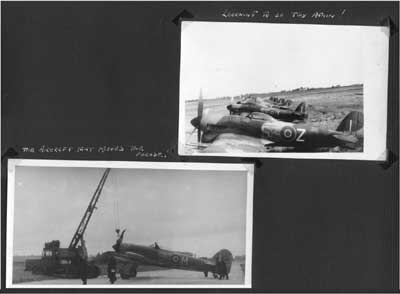
Copenhagen 1945
Top: Learning to be tidy again!
Bottom: The plane that missed the parade!!
CHRISTOPHER F. SHORES
2nd TAF. Color illustrations by Richard Ward OSPREY 1970
Osprey Publications Ltd., P.O. Box 25, 707 Oxford Road, Reading, Berks.
Copyright 1970 Osprey Publications Ltd. SBN 85045 030 6 First published 1970
Printed in Great Britain by The Berkshire Printing Co. Ltd., Reading
AIR SPOTTING POOL
(Units on attachment to 2nd T.A.F. only)
Lee-on-Solent 26 and 63 Squadrons Spitfires
132o Flight Typhoon IAs
808, 885, 886, and 897 Squadrons Seafires
(All Fleet Air Arm units)
On 29th a Spitfire squadron, No. 26, arrived at Lee-on-Solent from Hutton Cranswick. This unit was specially trained for the duties of
gun spotting for the Navy, but was to fly no operations until 6th June. A second unit, 63 Squadron, arrived at the same base a month later,
and both these units came under 2nd T.A.F. operational control, remaining under II Group of A.D.G.B. for administration.
Another new reconnaissance squadron also joined 2nd T.A.F. on 5th May, this being 69 Squadron; this unit was disbanded in the Mediterranean
area and re-formed at Northolt.
89 April, I944
During the early part of the month, 2 Squadron began exchanging its Mustang IAs for the faster Mark IIs. On 7th Nos. 2, 268 and 4I4 Squadrons
began Tac R sorties, leaving the naval spotting to 26 and 63 Squadrons; Flt/Lt Burroughes and Fg/Off Bromley Of 4I4 Squadron met and shot down a
Ju 52 on one of the first such missions. Two Spitfires failed to return, one from 16 Squadron on a MET sortie, and one from 26 Squadron on a naval
gun spotting sortie; the latter was hit by flak and went down in a sheet of flame.
Two of 26 Squadron's naval spotting Spitfires failed to return from a mid-day mission on 23rd, and two 4I4 Squadron Mustangs on an early
afternoon Tac R were attacked by seven Fw 190s
95 June, I944
After a few days at B-21 with 39 Wing, 414 Squadron was sent on temporary attachment to 127 (Spitfire) Wing at B 26 on 28th. With the
beginning of the big German retreat from Normandy in mid-August, most targets for the naval guns disappeared, but 26 Squadron continued to spot
for them throughout August and September, as they turned their attention to by-passed garrisons left behind in various coastal strongpoints.
September was to be for the reconnaissance units, as for others, a month of constant movement as the German armies cut their losses and
retreated swiftly to positions in Holland, and all Wings were continually falling behind the front at a rate whereby the increased distance to be
flown allowed only a few days operations, if any, from each new base before it was necessary to move on.
102 THE RECONNAISSANCE UNITS
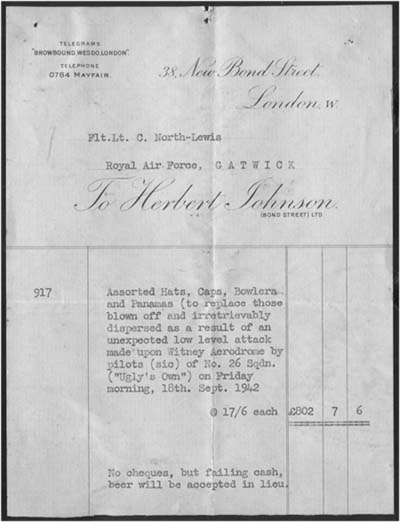
Did they fly under Tower Bridge too??????
|

